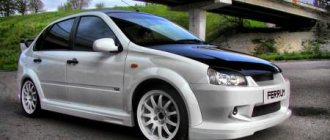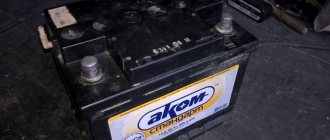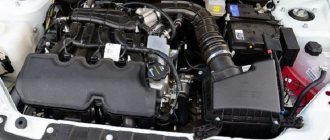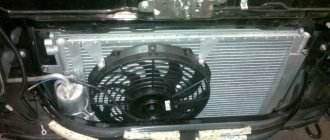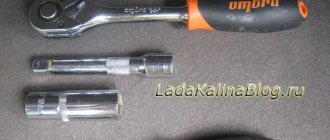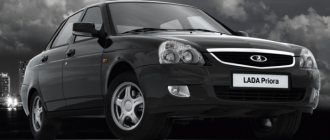Body
The body of the Lada Kalina car has 4 or 5 doors, depending on its type: sedan or station wagon, respectively. The sizes are also slightly different. For example, the station wagon has a length of 4084 mm, which is 40 mm longer than the sedan body. The width and height, on the contrary, are absolutely the same: 1700 mm and 1500 mm, respectively.
Since the Lada Kalina sedan and station wagon are built on the same model, the wheelbase dimensions are absolutely identical. The difference may be clearance. The sedan body has slightly more ground clearance than the cargo version. This is due to the fact that the luggage compartment is designed differently and the weight that falls on the rear axle is also not distributed equally. For example, the trunk of a VAZ sedan is smaller in size and located at the rear, resting entirely on the rear axle. But the station wagon has a longer luggage compartment, which allows part of the load to be transferred to the front axle.
The trunk volume is very different for different body types of Lada Kalina. The sedan has a volume of 400 liters, while the station wagon has 670. This allows you to take on more weight, at which the ground clearance will not decrease significantly.
Factory wheel size can vary from R13 to R14. Depending on which wheels will be installed on the VAZ Kalina, the ground clearance will also depend. But at the same time, there will be one drawback: if you load a lot of weight into the trunk, the wheels will rub against the arch.
The maximum carrying capacity of the Lada Kalina station wagon is 400 kg, and the sedan is 200. The weight of the car without passengers is 1160 kg and 1080 kg, respectively.
Engine
On the VAZ Kalina, 2 types of cylinder heads were installed: 16 and 8 valve. The eight-valve engine was installed on all standard models and had relatively low performance. The design of such an engine was much simpler, and it was cheaper to repair or replace parts.
The maximum power of the 8-valve engine is 87 hp, at which Lada Kalina can develop a maximum of 168 km/h. Acceleration to the first hundred is in 12.2 seconds. But the 16-valve engine has as much as 106 hp. The maximum speed of the VAZ Kalina, with such power, is 181 km/h. Acceleration from hundreds - in 11 seconds.
Engine with a volume of 1.6 liters and a power of 98 hp.
Despite the completely different device, fuel consumption does not differ much. The 87-horsepower engine has 6.6 liters, and the 106-horsepower engine has 6.5 liters per 100 km. At the same time, the dimensions of the cylinders are absolutely the same - 1600 cubic centimeters.
Main parameters and characteristics of the engine
VAZ-21114-50; VAZ-21114-90:
- Modifications of Lada-Kalina: VAZ-11173, VAZ-11183, VAZ-11193;
- Engine type: four-stroke, gasoline, with spark ignition and fuel injection system;
- Number of cylinders - 4;
- The cylinder arrangement is in-line;
- Cylinder diameter - 82 mm;
- Piston stroke - 75.6 mm;
- Cylinder displacement - 1.596 l;
- Power system - multipoint injection;
- Ignition system - electronic distributed type;
- Rated power - 59.5 kW;
- Rated crankshaft rotation speed - 5100-5300 rpm;
- Maximum torque - 120 Nm (at 2800-3200 rpm);
- The minimum crankshaft rotation speed at idle is 800-850 rpm;
- Fuel - gasoline "Premium-95" GOST R 51105-97.
VAZ-11194:
- Modifications of Lada-Kalina: VAZ-11174, VAZ-11184, VAZ-11194, Lada-Kalina Sport (1.4);
- Engine type: four-stroke, gasoline, 16-valve with spark ignition and fuel injection system;
- Number of cylinders - 4;
- The cylinder arrangement is in-line;
- Cylinder diameter - 76.5 mm;
- Piston stroke - 75.6 mm;
- Cylinder displacement - 1,390 l;
- Power system - multipoint injection;
- Ignition system - electronic distributed type;
- Rated power - 65.5 kW;
- Rated crankshaft rotation speed - 5500-5700 rpm;
- Maximum torque - 127 Nm (at 4200-4800 rpm);
- The minimum crankshaft rotation speed at idle is 810-870 rpm;
- Fuel - gasoline "Premium-95" GOST R 51105-97.
VAZ-21126:
- Modifications of Lada-Kalina: Lada-Kalina Sport (1.6);
- Engine type: four-stroke, gasoline, 16-valve with spark ignition and fuel injection system;
- Number of cylinders - 4;
- The cylinder arrangement is in-line;
- Cylinder diameter - 82 mm;
- Piston stroke - 75.6 mm;
- Cylinder displacement - 1.597 l;
- Power system - multipoint injection;
- Ignition system - electronic distributed type;
- Rated power - 72 kW;
- Rated crankshaft speed - 5600 rpm;
- Maximum torque - 145 Nm (at 4000 rpm);
- The minimum crankshaft rotation speed at idle is 850 rpm;
- Fuel - gasoline "Premium-95" GOST R 51105-97.
Fuel consumption and dynamic characteristics: VAZ-11183, VAZ-11193
- Engine: VAZ-21114 (Euro-3);
- Fuel consumption (combined cycle) - 7.8 l/100 km;
- Maximum speed - 170 km/h;
- Acceleration time to 100 km/h is 13 s.
Fuel consumption and dynamic characteristics: VAZ-11184, VAZ-11194
- Engine: VAZ-11194 (Euro-3);
- Fuel consumption (combined cycle) - 7.0 l/100 km;
- Maximum speed - 165 km/h;
- Acceleration time to 100 km/h is 12.2 s.
Fuel consumption and dynamic characteristics: Lada-Kalina Sport (1.4):
- Engine: VAZ-11194 (Euro-3);
- Fuel consumption (combined cycle) - 7.0 l/100 km;
- Maximum speed - 165 km/h;
- Acceleration time to 100 km/h is 12.2 s.
Fuel consumption and dynamic characteristics: Lada-Kalina Sport (1.6):
- Engine: VAZ-21126 (Euro-3);
- Fuel consumption (combined cycle) - 7.8 l/100 km;
- Maximum speed - 170 km/h;
- Acceleration time to 100 km/h is 11 s.
Lada-Kalina refueling volumes:
- Fuel tank - 50l;
- Engine lubrication system - 3.5 l;
- Engine cooling system and interior heater (the use of mixtures of coolants of different brands is not allowed) - 7.84 l;
- Gearbox - 3.1l;
- Hydraulic brake system - 0.45l;
- Windshield washer reservoir - 5 l;
- Rear window washer reservoir - 5 l.
Top of page
How much oil to pour into Kalina engine
The manufacturer recommends pouring 3.5 liters of oil into the engine crankcase
. It is this volume that is necessary for the normal operation and functioning of the car’s lubrication system. But if for some reason it is not possible to measure the volume, fill in engine oil until it is between the MIN and MAX marks on the dipstick.
Lack of lubrication in the engine can lead to oil starvation, which will have a very negative impact on the service life. If the level is too high, if it exceeds the maximum mark on the dipstick, it is possible to select some of it into the air filter bellows through the breather hose. From there it can get to the mass air flow sensor, which can lead to premature failure of this sensor.
Snapshot
Splash guards of the engine compartment and elements of their fastening (view from below the car): 1 - three screws with a key “8” for fastening the middle shield to the right shield; 2 — right shield; 3 - middle shield; 4 — four self-tapping screws “8” for fastening the middle shield to the lower cross member of the radiator frame; 5 — two self-tapping screws “8” for fastening the middle shield to the left shield; 6 — left shield; 7 - two 10mm key bolts securing the middle shield to the body side members.
How much oil to pour into the Kalina gearbox
The factory's recommendation for filling volume for a gearbox states that 3.1 liters of gear oil is required for the gearbox
. But according to many manuals of official publications, you can read that it is best to exceed this volume by some value.
Here it’s the other way around, it’s better that the level on the dipstick is slightly higher than the maximum, about 5 mm. This is necessary so that the fifth gear gears are better lubricated. Accordingly, this advice will extend the life of the transmission, or fifth speed in particular.
How much antifreeze or antifreeze to pour into the cooling system
Regarding the cooling and heating system of the Lada Kalina car interior, it is worth saying that the required coolant volume is 7.84 liters. If you look at all this visually, then with such a volume in the expansion tank, antifreeze or antifreeze will be located along the central mark of the tank.
You should not allow the coolant level in the conservator to drop excessively, as this will negatively affect engine cooling, as well as the normal operation of the interior heater.
Description of main faults
On Kalina 2 (2192, 2194), with regard to power units, there are a number of constant malfunctions. Why are they considered permanent? Most likely, this is due to design flaws that the designers cannot correct. So, let's look at which faults are more common than others.
The engine gets hot
The cause of this phenomenon is often the thermostat. As everyone knows, this is a common occurrence on cars produced by AvtoVAZ, starting with the “Classics”. To eliminate the problem, you need to replace the thermostat with a new one. But what to do if the reason is not in it, and the engine was heating up for another reason? It is worth determining why this is so and what the reasons are.
- Temperature sensor malfunction.
- The cooling fan has failed.
- Faulty wiring or electronic engine control unit.
Failure to comply with the temperature regime can lead to engine malfunction, and will also lead to significant malfunctions of the cylinder head and cylinder block. It is worth remembering that the recommended operating temperature of the Kalina engine is 87-103 degrees Celsius.
To ensure that the car does not heat up above the recommended values, it is necessary to check whether the cooling system and other related components are working properly.
How much gasoline does Kalina's fuel tank hold?
Regardless of what material your car’s fuel tank is made of: metal or plastic, its volume is the same and is 50 liters. Here, everyone decides at their own discretion how much gasoline to fill, but it is worth noting that it is undesirable to allow a situation in which the engine stalls due to running out of gasoline.
If the fuel pump often runs “dry”, so to speak, then this is fraught with a negative outcome, including complete failure of the fuel pump motor. So, when the fuel level in the tank drops to the red mark, it is advisable to refuel.
Capacity of the windshield and rear window washer reservoir (hatchback or station wagon)
On the Kalina sedan car, the washer is only on the windshield, since on similar body types it is not needed at the rear. But on a station wagon or hatchback there is also a rear washer. But the capacity of the washer fluid reservoir is the same for any of the three body types and is 5 liters.
A modern domestic car - what is it like? Externally, the Lada Kalina looks quite decent - a more or less modern car, the paint job is also very acceptable, the interior is ascetic, simple, but somehow pleasant. Of course, when driving, there is still a feeling of “Soviet” quality. According to press releases, Kalina is a car that has managed to approach the quality of city foreign cars! This car is one of the three best-selling cars in Russia at the moment. By the way, in the factory documentation, this model is designated by the index 11184. Surprisingly, even the simplest configuration includes power steering, power windows and even an alarm system with a central locking function in the list of its equipment. The steering ratio is 3.1, which means that the car handles very well for a modern 2011 car, which is also scheduled to go on sale in 2012. Surprisingly, this car is even equipped with climate control in the maximum configuration. It was assumed, according to the designers, that the car would be simple and unpretentious to maintain. However, history decided otherwise. There are even extremely interesting stories on the Internet about this AvtoVAZ model. For example, some items have a limited warranty of 1 year. So, it is not uncommon for one of these elements, the outboard bearing, to fail after a little over a year of operation. Failure of which leads to a broken timing belt, as well as serious engine defects. And as the moral of the whole story, when a car is under warranty, it is necessary to overhaul the engine or even require a complete replacement of the engine. And this is entirely at your own expense. And most owners regularly call for services during the first year of operation. By the way, the Lada Kalina sells well only in Russia; our closest neighboring countries (Belarus, Ukraine, Kazakhstan) cannot boast of the same sales and distribution - this car is a rare guest there! And at the moment Kalina is available in 3 body styles - sedan, hatchback, station wagon. We hope that you found this review of the model interesting.
Volume of fluid in the brake system
Basically, the brake system holds from 0.55 to 1.0 liters of fluid, this depends both on whether the car has an ABS system and on the size of the car. The period for replacing brake fluid in most cars is 2-3 years of use, or 40-60 thousand mileage. To determine a more specific interval, you need to look at a specific fluid standard and driving characteristics. For example, in sports cars the TZ is changed every 5-10 thousand.
But since the question of the required volume of brake fluid in the system and its standard is asked only by owners of ordinary cars, and not premium or business class ones, we will give specific examples for cars popular in the CIS countries.
What and how much brake fluid is in some cars
| Table of the volume of brake fluid required for replacement | ||
| car model | DOT class | Required amount of fuel fluid, l |
| Ford Focus 2 | DOT4 | 1 |
| Ford Focus 3 | DOT4 | 1 |
| Ford Kuga | DOT4 | 1 |
| Chevrolet Niva | DOT4 | 1 |
| Chevrolet Cruze | DOT4 | 1 |
| Chevrolet Lacetti | DOT 4 | 0.5 a with ABS and ESP 1.0 |
| Kia Sid | DOT4 | 1 |
| Kia Rio 3 | DOT4 | 1 |
| Kia Rio 2 | DOT 4 | with ABS - 1-1.5 l without - 1 l |
| Kia Sorento | DOT 5.1 | 1 |
| Kia Spectra | DOT3, DOT4 | 1 |
| Renault Logan | DOT 4 | with ABS – 1-1.5 l without – 0.7 l |
| Renault Duster | DOT4 | 1 |
| Renault Fluence | DOT4 | 0,5-1 |
| Renault Sandero | DOT4 | 1 |
| Renault Megane 2 | DOT4 | 1 |
| VAZ 2107, 2109 | DOT 3 | 0,55 |
| VAZ 2114, VAZ 2115 | DOT 4 | 1 |
| VAZ 2108, 2110, 2112 | DOT 4 | 1 |
| Lada Kalina | DOT 4 | 1 |
| Lada Priora (VAZ 2170) | DOT 4 | 1 |
| Lada Granta | DOT 4 | 1 |
| Lada Largus | DOT 4+ | 1 |
| Daewoo Matiz | DOT 4 | 1 |
| Mitsubishi Pajero 4 | DOT 4 | 1 |
| Mitsubishi Lancer IX | DOT 3, DOT 4 | 1 |
| Mitsubishi Lancer 10 | DOT 4 | 1 |
| Mazda Demio | DOT 3, DOT 4 | 1 |
| Mazda 3 | DOT 5.1 | 1 |
| Mazda cx 5 | DOT 4 | 1 |
| Skoda Superb II | with ABS DOT 4 | 1 |
| SKODA Octavia A5 | DOT 4 | 1 |
| Toyota RAV4 | DOT 3, DOT 4 | 0,5 |
| Toyota Corolla | DOT 4 | 1 |
| Toyota Prado 150 | DOT 4, DOT 5.1 | 1,5-1,6 |
| Volkswagen Polo sedan | DOT 4 | 1 |
| Daewoo Nexia | DOT 4, DOT 5.1 | 1 |
| Hyundai Solaris | DOT 4 | 1 |
| Hyundai Accent | DOT 5.1 | 1-1,5 |
| Volvo XC70 | DOT 4+ | 1 |
| Nissan Tiida | DOT 4 | 1 |
| Nissan Qashqai | DOT 4 | 1 |
| Nissan X Trail | DOT 3, DOT 4 | 1 |
How much brake fluid is in the VAZ system
As you can see in the TZ volume table, VAZ cars are filled with brake fluid of the DOT-4 standard, but its amount in the brake system can be from 550 ml in classics (VAZ 2107), to 1.0 liters in more modern domestic cars, such as VAZ 2110 or Kalina. But if you replace the TJ with flushing, then you should take 1.5 liters, and since there is no such packaging, you will have to buy two liter bottles.
However, remember that when opened, the shelf life of brake fluid is limited to two years.
How often to change brake fluid
Useful recommendations on how often to change the brake fluid in a car. Regulations on the frequency of changing brake fluid.
How to bleed the brakes
To properly bleed the brakes, you need to know the bleeding procedure specified by the car manufacturer. However, such mistakes should not be made...
Bleeding the brakes without an assistant
Bleeding your brakes can be a challenging task at times. But there is a simple way to do it without an assistant. See instructions for bleeding your car's brakes yourself.
A little history
Lada Kalina is a laconic, but attractive, dynamic budget car designed for city driving. The Lada Kalina model made its presence known back in the early 2000s, although development of the project had been going on since the early 90s. The first generation of Kalina was not as reliable as the manufacturer promised. Moreover, a huge batch was recalled from stores for revision.
Even the President of the Russian Federation advertised the restyled generation of Lada. Having driven the yellow Kalina, he rehabilitated the car, attracting the close attention of a multimillion-dollar audience to it. In 2013, an updated version of Kalina was launched, which became even brighter, more functional and more comfortable (see photo). Here we can see a new automatic transmission, the pride of AvtoVAZ, and numerous changes regarding both the external part and technical parameters.
According to the management of the enterprise, AvtoVAZ is not going to stop at the achieved successes. In the near future, most likely, an even more improved version will be launched, which will pleasantly surprise you with an abundance of functions and good dynamics.
Technical parameters of Kalina
Let's look at the characteristics of the car. Lada Kalina has been produced since 2004. Over the years of production, a large number of modifications have been released for sale: from standard and cheap to luxury and sports, which have performed well at major international competitions. The car is available in several body versions:
- four-door sedan (discontinued);
- five-door hatchback;
- five-door station wagon.
Each of these versions is popular. Body length in the hatchback version is 3850 mm, station wagon - 4040 mm. The width in all versions is 1700 mm, height - 1500 mm, wheelbase - 2470 mm. The ground clearance of the hatchback is small - only 160 mm, while the ground clearance of the station wagon is better - already 185 mm.
Each car is designed for 5 passengers, it is a universal and practical option. Moreover, there is enough space in the cabin to feel comfortable. This especially applies to the sedan and station wagon, which have larger dimensions than the hatchback.
The Lada Kalina car is characterized by good carrying capacity, the curb weight is 1110 kg, and the maximum is 1585 kg. Lada Kalina is produced in 4 trim levels:
Each is good in its own way. The basic one cannot please you with rich equipment, but it costs much less. Norma is the golden mean, where you can purchase good quality and equipment for a reasonable price.
Lux is a car for aesthetes and connoisseurs of quality. Finally, sport is the pride of AvtoVAZ, powerful, dynamic, spectacular, it leaves extremely positive driving emotions. Numerous reviews from owners confirm this statement.
Lada Kalina has several types of engines: standard 8-valve and new 16-valve 1.6-liter engines with a capacity of 82, 87, 98 and 118 hp. With. (sports version), working with front-wheel drive and two types of transmission, a standard 5-speed manual and a 4-speed automatic transmission assembled by Japanese craftsmen.
The maximum speed of Kalina, if we mean the regular versions and not the sport version, is 170 km/h. The sports model accelerates to almost 200. Kalina’s characteristics are quite good, opening up great opportunities for the driver. The price of a car varies from 350,000 to 510,000 rubles. depending on the modification and dealer.
The Lada Kalina sedan is one of the body variants of a popular car in our country. In general, the history of this model began back in 1993, when VAZ was faced with the task of developing a modern car. But the first name of the model was announced only in 1998. A year later, a prototype appeared, which subsequently successfully passed all the necessary tests, and Kalina prepared for serial production. True, the sedan was developed only in 200. At the same time, the manufacturer signed a document that determined the fate of the model - Kalina will be produced. A lot of time has passed since then, and in 2004 the plant produced the first production car. It was a Lada Kalina sedan. Yes, the four-door modification became the first-born of the entire family, which now has several versions. High-tech style, noble body design and a revolution in the design of the car’s exterior are the main advantages of the model. Thanks to them, Kalina became popular. Moreover, the sedan car took first place in sales: this modification was ahead of the hatchback by a thousand cars in 2009. But what is the four-door Kalina? This is a dynamic, progressive and roomy car with relatively small dimensions. Despite the presence of a spacious trunk, the length of the sedan is within 4 meters. Such a short body is ideal for city traffic jams, and finding parking near a shopping center is noticeably simplified: even the width of Kalina is only 1.7 meters. When looking at the sedan from the side, you can notice the high stern. This design decision made it possible to increase the volume of the trunk and complement the design of Kalina: a high trunk is better combined with a high body and a large glass area. But in general, there are no huge differences from the hatchback - the sedan only has four doors and a slightly increased body length. Otherwise the modifications are identical.
Quantity of special fluids and oils in LADA Kalina
A family car that often has questions about consumables.
Each unit requires its own type of oil and preferably of good quality. With a careful approach, Kalina shows itself as a reliable family car and a replacement for foreign analogues. The Kalina prototype was created back in 1999, and put into production in 2004. The first generation was represented by a sedan and a hatchback, then they were joined by a station wagon. The first models had an eight-valve 1.6 engine (81 hp), then a sixteen-valve 1.4 engine (98 hp) appeared, plus the Lada Kalina Sport with a reinforced engine was produced in a limited edition. The hatchback and station wagon lasted the longest. The sports version did not gain popularity due to the controversial characteristics of the engine.
Lada Kalina salon
The interior decoration of the four-door version also does not distinguish it from other modifications. However, the Lada Kalina sedan is characterized by a trunk increased by 165 liters compared to the hatchback. This increase allows the car owner to use the car for shopping or transporting things to the country. Yes, with the 235-liter trunk of the five-door Kalina, you can’t really go wild. But 400 liters is a completely different matter. Sales of Kalina have reached such proportions that this model has become the fourth best-selling car in Russia. As for the design, the Lada Kalina sedan, like all other versions, is distinguished by improved safety and adaptability to modern operating conditions. Excellent optics (the headlights shine brightly), very comfortable entry into the cabin (the opening angle of the doors in Kalina is noticeably larger when compared with other VAZ models), galvanized body (the lower part of the car is resistant to corrosion and the influence of reagents), wide doorways (despite at a large door opening angle, the domestic car also stands out for its surprisingly wide door openings) and excellent visibility - these are the key qualities of any version of Kalina. They also apply to the sedan. As mentioned above, the four-door modification also has a more spacious trunk, and this is appreciated by many car owners. This means that the sedan is also suitable as a family car. However, to the main qualities of this model we can add the low cost of the design. Relatively low costs for a car made it possible to develop a budget car based on Kalina, called Granta. The new model is based on the sedan, and it has become much cheaper than the donor model. Therefore, an important advantage of the Lada Kalina can be confidently called the ability to reduce the cost of producing a car by simplifying the design. Lada Kalina is a universal model that served as the basis for a new family of budget cars. Another interesting fact is that the next generation of this car will soon appear, which promises to be even more progressive.
The Lada Kalina sedan is one of the most important modifications of the model, but it has already been discontinued. True, the configuration of an already departed car can be assessed. Thus, the basic configuration of the sedan was equipped with a 1.6-liter unit with a capacity of only 81 hp. With. Such a car can accelerate to 160 km/h, and fuel consumption is within reasonable limits. Kalina with a 1.6 engine requires less than 8 liters of gasoline. Among the interesting facts, we note that the engine complies with Euro-3 standards, and the fuel tank holds 50 liters of fuel. Thus, the car will be able to travel about 600 kilometers with a full tank. Expensive and innovative foreign cars show much higher mileage, but for a car in the budget segment such characteristics are quite acceptable. The next engine has a volume of 1.4 liters, and the final power of the unit is 89 “horses”. This Lada Kalina consumes only 7 liters of gasoline, and the maximum speed reaches the same 160 km/h. There are few differences between the two engines listed above, and they lie in volume, fuel consumption and power. But there is also a third engine. This is a 1.6-liter 98-horsepower gasoline engine. The Lada Kalina sedan is offered with this power unit only in the “Lux” version, which includes alloy wheels, air conditioning, fog lights, heated front seats, safety bars and ABS. With such equipment, the model cost 351 thousand rubles. Speaking of technical characteristics, it is worth noting the efficiency (only 7.2 liters of fuel for as much as 100 kilometers) and a fairly high maximum speed (the four-door Lada Kalina with a 98-horsepower engine develops 183 kilometers per hour). Returning to the engine, you can see that it meets the same Euro-3 requirements.
Should I wash Kalina or not?
The choice of technology depends on the degree of engine wear (mileage). If this figure does not exceed 30 thousand km, flushing may not be done. However, at a higher value, coking occurs in the power plant, and carbon deposits form on the pistons and liners. It is recommended to partially remove it by washing.
There is a lot of controversy regarding flushing fluids. Experienced auto mechanics recommend using oil as a flush. The method is to replace it every 1-2 thousand km. mileage, after which new fluid is added.
The disadvantage of washing is the complexity of the process. If you follow the exact technology, you need double the volume of new oil. The reason is that after replacement, part of the flush remains in the crankcase; it must be drained along with the rest of the liquid and new oil filled in.
